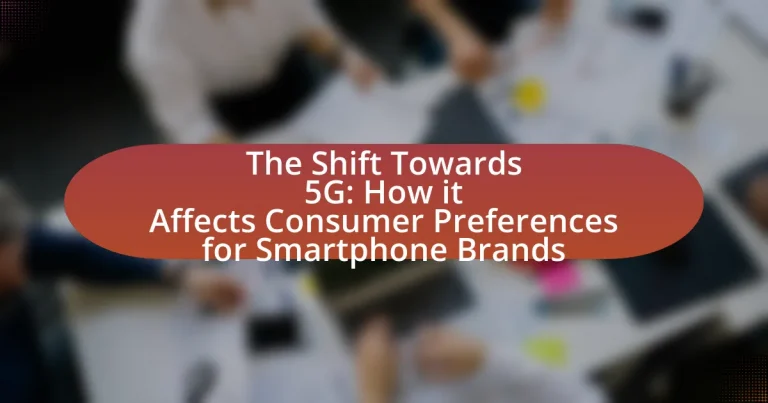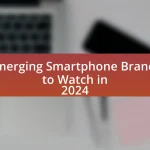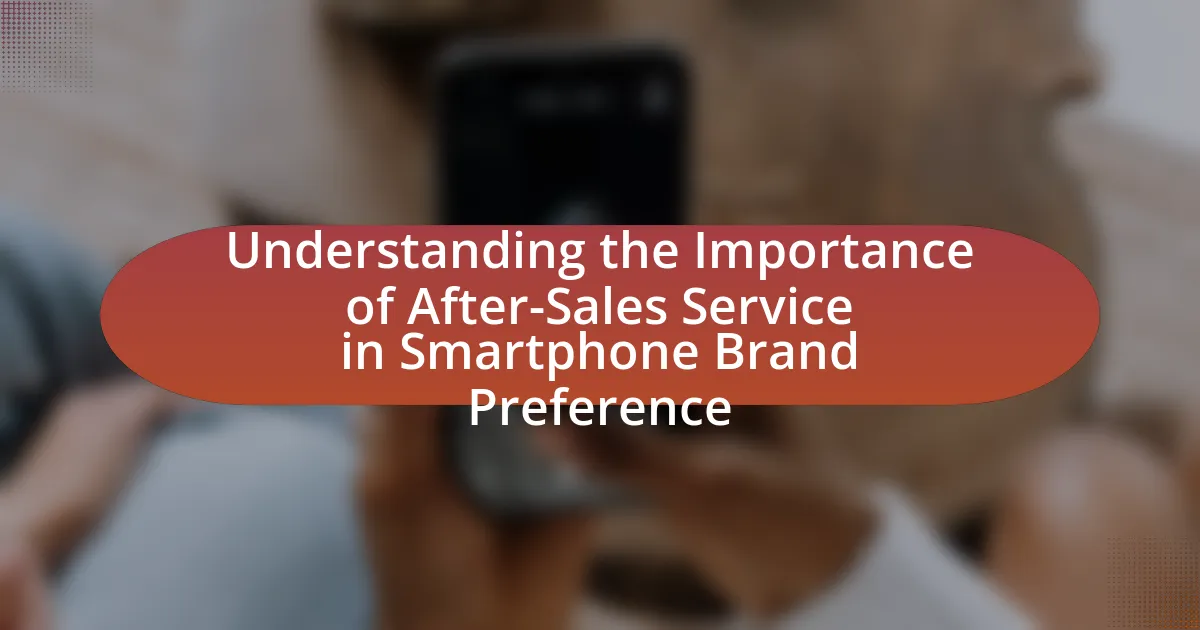The article focuses on the shift towards 5G technology and its impact on consumer preferences for smartphone brands. It highlights the significant advancements offered by 5G, including faster data speeds, lower latency, and enhanced connectivity, which are transforming user experiences and influencing purchasing decisions. Key factors affecting consumer behavior include the demand for high-speed internet, device compatibility, and brand reputation. The article also explores how demographic differences shape preferences for 5G smartphones and outlines future trends in technology and marketing strategies that smartphone brands should adopt to meet evolving consumer expectations.
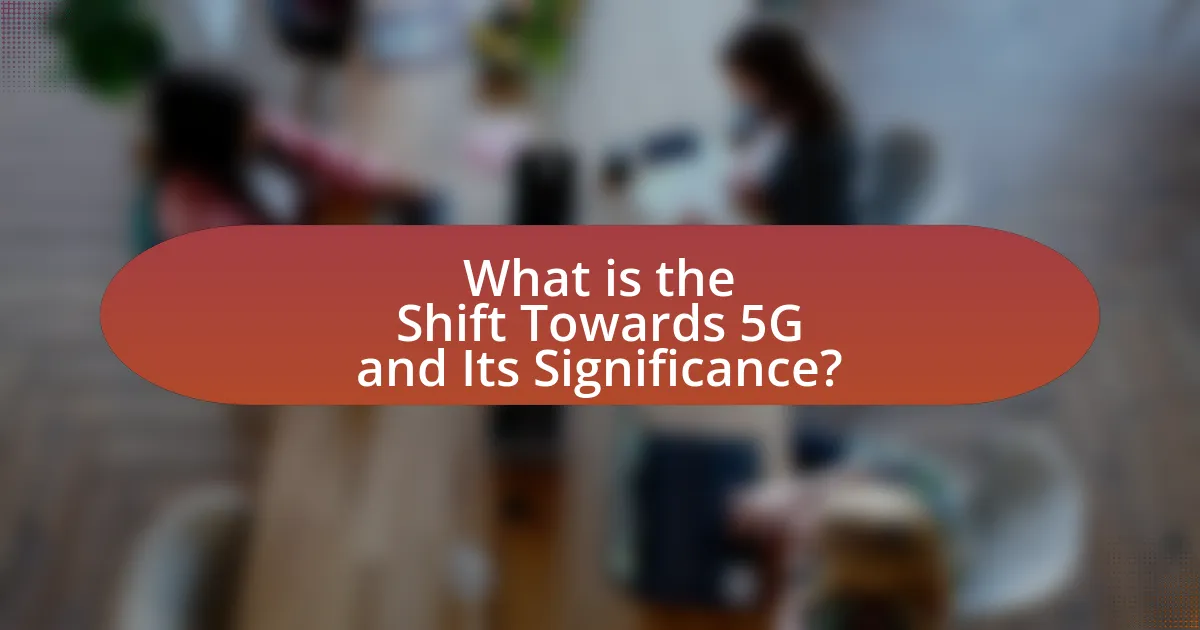
What is the Shift Towards 5G and Its Significance?
The shift towards 5G refers to the global transition from 4G LTE networks to fifth-generation wireless technology, which offers significantly faster data speeds, lower latency, and greater connectivity. This transition is significant because it enables advancements in various sectors, including IoT, autonomous vehicles, and enhanced mobile broadband, thereby transforming consumer experiences and expectations. For instance, 5G can support up to one million devices per square kilometer, compared to 4G’s 100,000, facilitating the growth of smart cities and connected devices. As a result, consumer preferences for smartphone brands are increasingly influenced by 5G capabilities, as users seek devices that can leverage these enhanced network features for improved performance and functionality.
How does the transition to 5G technology impact consumer behavior?
The transition to 5G technology significantly alters consumer behavior by increasing demand for high-speed internet and advanced mobile applications. As consumers experience faster download and upload speeds, they are more likely to engage in data-intensive activities such as streaming high-definition content, participating in augmented reality experiences, and utilizing cloud-based services. This shift leads to a preference for smartphone brands that offer 5G compatibility, as evidenced by a report from Counterpoint Research indicating that 5G smartphone sales are projected to reach 1.5 billion units by 2025, reflecting a growing consumer inclination towards devices that support this technology.
What are the key features of 5G that attract consumers?
The key features of 5G that attract consumers include significantly faster data speeds, lower latency, and enhanced connectivity. These features enable users to download large files in seconds, stream high-definition content without buffering, and connect multiple devices seamlessly. For instance, 5G can achieve speeds up to 10 Gbps, which is up to 100 times faster than 4G, allowing for improved user experiences in applications like virtual reality and augmented reality. Additionally, the reduced latency of around 1 millisecond enhances real-time communication and gaming experiences, making 5G particularly appealing to tech-savvy consumers.
How does 5G enhance user experience compared to previous generations?
5G enhances user experience compared to previous generations by providing significantly faster data speeds, lower latency, and greater network capacity. Specifically, 5G can achieve download speeds exceeding 10 Gbps, which is up to 100 times faster than 4G, allowing for seamless streaming and quicker downloads. Additionally, 5G reduces latency to as low as 1 millisecond, enabling real-time interactions in applications such as gaming and video conferencing. Furthermore, the increased capacity of 5G networks supports a higher number of connected devices, improving performance in densely populated areas. These advancements lead to a more efficient and responsive user experience, making applications more accessible and enjoyable.
Why is 5G important for smartphone brands?
5G is important for smartphone brands because it significantly enhances data speeds and connectivity, enabling advanced features and applications. This technology allows for faster downloads, improved streaming quality, and seamless connectivity for IoT devices, which are increasingly integrated into smartphones. According to a report by Ericsson, 5G networks can deliver speeds up to 100 times faster than 4G, making it essential for brands to adopt this technology to meet consumer demands for high-performance devices. As consumers prioritize speed and connectivity, smartphone brands that incorporate 5G capabilities are more likely to attract and retain customers in a competitive market.
What competitive advantages do brands gain by adopting 5G technology?
Brands gain significant competitive advantages by adopting 5G technology, primarily through enhanced speed, lower latency, and increased connectivity. These factors enable brands to deliver superior user experiences, such as faster download and upload speeds, which can lead to higher customer satisfaction and retention. For instance, 5G networks can support up to 1,000 times more data traffic than 4G, allowing brands to offer seamless streaming and real-time applications. Additionally, the ability to connect a larger number of devices simultaneously enhances the potential for innovative services, such as augmented reality and IoT applications, which can differentiate brands in a crowded market. This technological edge can result in increased market share and improved brand loyalty as consumers gravitate towards brands that provide cutting-edge experiences.
How does 5G influence brand loyalty among consumers?
5G significantly enhances brand loyalty among consumers by providing faster data speeds, lower latency, and improved connectivity, which leads to a better user experience. As consumers experience seamless streaming, quicker downloads, and enhanced mobile applications, they develop a stronger preference for brands that effectively leverage these 5G capabilities. Research indicates that 82% of consumers are more likely to remain loyal to brands that offer superior connectivity and performance, highlighting the direct correlation between 5G technology and increased brand loyalty.

How Does 5G Affect Consumer Preferences for Smartphone Brands?
5G significantly influences consumer preferences for smartphone brands by prioritizing devices that support faster connectivity and enhanced performance. As consumers increasingly seek high-speed internet access for activities like streaming, gaming, and remote work, brands that offer 5G compatibility are more appealing. For instance, a survey by Deloitte in 2021 indicated that 61% of consumers consider 5G capability a key factor in their smartphone purchasing decisions. This trend drives brands to innovate and market their 5G features prominently, thereby shaping consumer choices towards those that deliver superior connectivity experiences.
What factors influence consumer choice in the context of 5G?
Consumer choice in the context of 5G is influenced by several key factors, including network availability, device compatibility, pricing, and perceived benefits. Network availability is crucial, as consumers are more likely to choose 5G-enabled devices if they can access 5G networks in their area. Device compatibility also plays a significant role; consumers tend to prefer smartphones that support 5G technology, as this ensures they can utilize the faster speeds and lower latency that 5G offers. Pricing is another important factor; competitive pricing for 5G plans and devices can drive consumer adoption. Lastly, perceived benefits, such as improved streaming quality, faster download speeds, and enhanced gaming experiences, significantly impact consumer preferences, as individuals are more inclined to invest in 5G technology when they understand its advantages.
How do pricing strategies change with the introduction of 5G smartphones?
The introduction of 5G smartphones leads to a shift in pricing strategies, primarily resulting in higher initial prices due to increased production costs and advanced technology integration. Manufacturers often position 5G smartphones as premium products, reflecting their enhanced capabilities, such as faster data speeds and improved connectivity. For instance, in 2020, the average price of 5G smartphones was approximately 20% higher than that of 4G models, as reported by Counterpoint Research. This premium pricing strategy is aimed at capturing early adopters willing to pay more for cutting-edge technology, while also allowing companies to recoup investments in 5G infrastructure and development.
What role does brand reputation play in consumer decisions for 5G devices?
Brand reputation significantly influences consumer decisions for 5G devices by establishing trust and perceived quality. Consumers often associate well-known brands with reliability and advanced technology, which is crucial when adopting new technologies like 5G. Research indicates that 70% of consumers are more likely to purchase a product from a brand they trust, highlighting the importance of reputation in driving sales. Additionally, brands with strong reputations tend to have higher customer loyalty, which is essential in a competitive market where consumers are evaluating multiple options for 5G devices.
How do consumer demographics affect preferences for 5G smartphones?
Consumer demographics significantly influence preferences for 5G smartphones, as factors such as age, income, and education level shape technology adoption and usage patterns. Younger consumers, particularly millennials and Gen Z, tend to prioritize advanced features and connectivity, making them more inclined to choose 5G smartphones for enhanced mobile experiences. In contrast, older demographics may prioritize reliability and cost-effectiveness, leading to a slower adoption rate of 5G technology.
Income levels also play a crucial role; higher-income consumers are more likely to invest in the latest technology, including 5G smartphones, while lower-income groups may opt for more affordable options. Additionally, education level correlates with technology awareness and usage, with more educated consumers showing a greater interest in the benefits of 5G, such as faster download speeds and improved streaming capabilities.
Research from the Pew Research Center indicates that 85% of adults aged 18-29 own a smartphone, compared to 53% of those aged 65 and older, highlighting the generational divide in smartphone ownership and preferences. This demographic analysis underscores how consumer characteristics directly impact the market dynamics for 5G smartphones.
What are the preferences of younger consumers regarding 5G smartphones?
Younger consumers prefer 5G smartphones that offer high-speed connectivity, advanced camera features, and sleek designs. Research indicates that 70% of consumers aged 18-24 prioritize fast internet speeds for streaming and gaming, while 65% value camera quality for social media sharing. Additionally, 60% of this demographic favors brands that provide innovative features and aesthetic appeal, reflecting a trend towards stylish and functional devices.
How do older consumers perceive the value of 5G technology in smartphones?
Older consumers generally perceive the value of 5G technology in smartphones as limited, primarily due to a lack of understanding of its benefits. Many older individuals prioritize features such as ease of use, battery life, and camera quality over high-speed connectivity. According to a survey by the Pew Research Center, only 29% of adults aged 65 and older reported being very familiar with 5G technology, indicating a significant knowledge gap. This unfamiliarity leads to skepticism about the necessity of 5G, as older consumers often do not see immediate advantages that justify the upgrade from 4G.
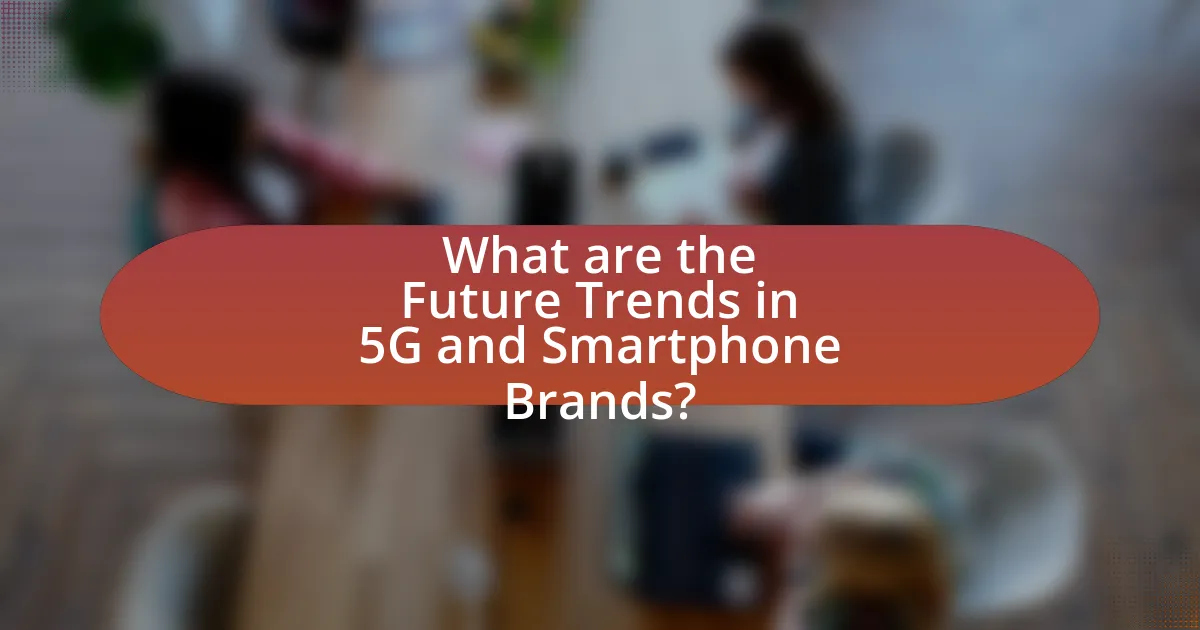
What are the Future Trends in 5G and Smartphone Brands?
Future trends in 5G and smartphone brands include the widespread adoption of 5G technology, leading to enhanced mobile experiences and increased demand for compatible devices. As of 2023, major smartphone manufacturers like Samsung, Apple, and Xiaomi are prioritizing 5G capabilities in their new models, reflecting consumer preferences for faster data speeds and improved connectivity. According to a report by GSMA Intelligence, global 5G connections are expected to reach 1.7 billion by 2025, indicating a significant shift in consumer behavior towards 5G-enabled smartphones. Additionally, innovations such as improved battery life, advanced camera systems, and integration of AI features are becoming standard in new 5G smartphones, further influencing brand competition and consumer choices.
How will the evolution of 5G technology shape future smartphone designs?
The evolution of 5G technology will significantly influence future smartphone designs by necessitating enhanced hardware capabilities, improved thermal management, and innovative form factors. As 5G networks offer faster data speeds and lower latency, smartphones will require advanced processors and antennas to fully utilize these benefits, leading to the integration of more powerful chipsets and multiple antenna systems. Additionally, the increased energy demands of 5G will drive the need for better battery technology and efficient thermal solutions to prevent overheating. Furthermore, the design may shift towards slimmer and lighter devices that can accommodate these new components while maintaining user comfort and aesthetics. This evolution aligns with market trends, as a report from the Global System for Mobile Communications (GSMA) indicates that 5G subscriptions are expected to reach 1.7 billion by 2025, prompting manufacturers to adapt their designs to meet consumer expectations for high-performance mobile experiences.
What innovations can we expect in 5G smartphones over the next few years?
Innovations in 5G smartphones over the next few years will include enhanced processing power, improved battery technology, and advanced camera systems. Manufacturers are expected to integrate more powerful chipsets, such as Qualcomm’s Snapdragon 8 Gen 2, which will enable faster data processing and improved AI capabilities. Additionally, battery technology will evolve with the introduction of solid-state batteries, offering longer life and quicker charging times. Camera systems will likely incorporate higher megapixel sensors and advanced computational photography features, enhancing image quality in various lighting conditions. These advancements are driven by consumer demand for faster connectivity, better performance, and superior multimedia experiences.
How will consumer expectations change as 5G becomes mainstream?
As 5G becomes mainstream, consumer expectations will shift towards higher performance, faster connectivity, and enhanced user experiences. Consumers will anticipate seamless streaming, instantaneous downloads, and improved responsiveness in applications, driven by 5G’s significantly lower latency and higher data transfer rates compared to 4G. Research indicates that 5G can deliver speeds up to 100 times faster than 4G, which will lead consumers to expect more from their devices, including advanced features like augmented reality and smart home integration. This heightened expectation will compel smartphone brands to innovate rapidly to meet the demands for superior technology and performance.
What strategies should smartphone brands adopt to meet changing consumer preferences?
Smartphone brands should adopt strategies that prioritize 5G technology integration, enhanced user experience, and sustainability to meet changing consumer preferences. As consumer demand shifts towards faster connectivity and improved performance, brands must ensure their devices are 5G-ready, as evidenced by the fact that 5G subscriptions are projected to reach 1.7 billion by 2025, according to the GSMA. Additionally, brands should focus on user-centric features such as improved camera capabilities and longer battery life, which are increasingly important to consumers. Sustainability initiatives, such as using eco-friendly materials and promoting recycling programs, are also crucial, as a survey by Deloitte found that 47% of consumers consider sustainability when purchasing electronics. By aligning their strategies with these consumer preferences, smartphone brands can effectively respond to the evolving market landscape.
How can brands effectively market their 5G capabilities to consumers?
Brands can effectively market their 5G capabilities to consumers by highlighting the enhanced speed, connectivity, and user experience that 5G technology offers. For instance, brands can showcase real-world applications of 5G, such as faster download speeds for streaming high-definition content or improved performance in online gaming, which can resonate with tech-savvy consumers. According to a report by GSMA, 5G networks are expected to deliver download speeds up to 10 times faster than 4G, making it a compelling selling point. Additionally, brands can leverage social media campaigns and influencer partnerships to demonstrate the practical benefits of 5G in everyday life, thereby increasing consumer awareness and interest.
What best practices should brands follow to enhance customer satisfaction with 5G smartphones?
Brands should prioritize user education and seamless integration of 5G technology to enhance customer satisfaction with 5G smartphones. Educating consumers about the benefits and capabilities of 5G, such as faster download speeds and improved connectivity, can help users appreciate the value of their devices. Additionally, ensuring that smartphones are compatible with various 5G networks and providing regular software updates can enhance performance and user experience. According to a study by Deloitte, 5G users report higher satisfaction levels when they understand the technology and its advantages, indicating that informed customers are more likely to be satisfied with their purchases.
